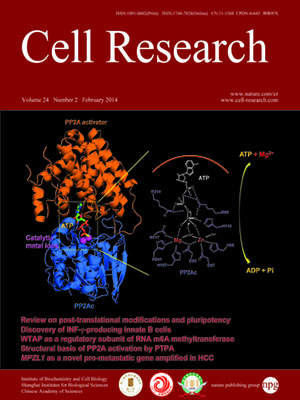
Volume 24, No 2, Feb 2014
ISSN: 1001-0602
EISSN: 1748-7838 2018
impact factor 17.848*
(Clarivate Analytics, 2019)
Volume 24 Issue 2, February 2014: 143-160 | Open Access
REVIEW
Protein post-translational modifications and regulation of pluripotency in human stem cells
Yu-Chieh Wang1, Suzanne E Peterson1 and Jeanne F Loring1
1Department of Chemical Physiology, Center for Regenerative Medicine, The Scripps Research Institute, 10550 N. Torrey Pines Rd., La Jolla, CA 92037, USA
Correspondence: Yu-Chieh Wang, Tel: +1-858-784 7139; Fax: +1-858-784 7211 E-mail: ycwang@scripps.edu; Jeanne F Loring, Tel: +1-858-784 7362; Fax: +1-858-784 7211(jloring@scripps.edu)
Post-translational modifications (PTMs) are known to be essential mechanisms used by eukaryotic cells to diversify their protein functions and dynamically coordinate their signaling networks. Defects in PTMs have been linked to numerous developmental disorders and human diseases, highlighting the importance of PTMs in maintaining normal cellular states. Human pluripotent stem cells (hPSCs), including embryonic stem cells (hESCs) and induced pluripotent stem cells (hiPSCs), are capable of self-renewal and differentiation into a variety of functional somatic cells; these cells hold a great promise for the advancement of biomedical research and clinical therapy. The mechanisms underlying cellular pluripotency in human cells have been extensively explored in the past decade. In addition to the vast amount of knowledge obtained from the genetic and transcriptional research in hPSCs, there is a rapidly growing interest in the stem cell biology field to examine pluripotency at the protein and PTM level. This review addresses recent progress toward understanding the role of PTMs (glycosylation, phosphorylation, acetylation and methylation) in the regulation of cellular pluripotency.
10.1038/cr.2013.151
FULL TEXT | PDF
Browse 1816


